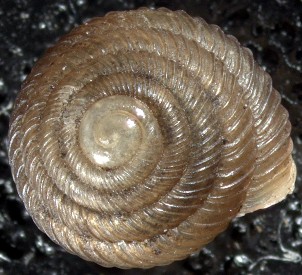Interactions
Many organisms prefer to live and search for food in damp terrestrial habitats that are inhabited by S. affinis. Among these organisms are other terrestrial snails, snakes, insects, salamanders, beetles, and plants such as ferns. One might also find small ground rodents such as shrews and mice in the same habitat. Unfortunately these animals are also predators to land snails (Dourson, 2006). More information on S. affinis habitat and organisms that can be found in the same habitat can be found on the Habitat page of this website.
One example of a terrestrial snail predator is the Jefferson's Salamander. The Jefferson's Salamander or Ambystoma jeffersonianum has been known to eat Strobilops aenea and Strobilops labyrinthica (Judd, 1957). Both of these species are closely related to S. affinis.
Strobilops affinis is a small terrestrial snail with a diameter between 2.75mm and 2.80mm (Pilsbry, 1927-1939, 1939-1948). This makes S. affinis an easy food target for larger animals in the food web. Terrestrial snails are considered to be low on the food chain because of their high numbers and nutritious value to organisms higher on the food chain (Hotopp, 2005).
Another interaction that most snails have is with parasitic worms. Most mollusks are infected with parasitic worms and many snails serve as intermediate hosts in the complex lifecycles of trematode worms (Burch, 1962). Little is known about the specific role that S. affinis plays in parasitic life cycles.
No studies were found that indicated S. affinis has human uses or effects on humans. Escargot is used to describe meals that contain land snails. Escargot typically contains land snails in the genus Helix (Toader-Williams, 2009). Land snails of the Eastern United States, like S. affinis, may have once been used as food for Native Americans but are not used as food today in human diets. Only freshwater snails have shown to be medically significant to humans. Studies have not been conducted to test if S. affinis has medical significance to humans (Burch, 1962).
Where can I find more information and
information used to make this website?
HOME
